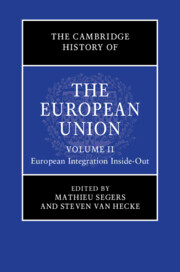Book contents
- The Cambridge History of the European Union
- The Cambridge History of the European Union
- The Cambridge History of the European Union
- Copyright page
- Contents
- Figures
- Tables
- Contributors to Volume II
- Acknowledgements
- Abbreviations
- Reflections on the History and Historiography of European Integration
- Part I Milestones: Treaties and Treaty Changes
- 1 Early Forms of European Unity
- 2 From Messina and Rome to the Single European Act
- 3 The Making of the European Union
- 4 From Maastricht and Copenhagen to Amsterdam and Nice
- 5 The Constitution Project, Lisbon and Beyond
- 6 Moving beyond British Exceptionalism
- Part II Instruments of Integration
- Part III Narratives and Outcomes
- Index
- References
5 - The Constitution Project, Lisbon and Beyond
from Part I - Milestones: Treaties and Treaty Changes
Published online by Cambridge University Press: 12 October 2023
- The Cambridge History of the European Union
- The Cambridge History of the European Union
- The Cambridge History of the European Union
- Copyright page
- Contents
- Figures
- Tables
- Contributors to Volume II
- Acknowledgements
- Abbreviations
- Reflections on the History and Historiography of European Integration
- Part I Milestones: Treaties and Treaty Changes
- 1 Early Forms of European Unity
- 2 From Messina and Rome to the Single European Act
- 3 The Making of the European Union
- 4 From Maastricht and Copenhagen to Amsterdam and Nice
- 5 The Constitution Project, Lisbon and Beyond
- 6 Moving beyond British Exceptionalism
- Part II Instruments of Integration
- Part III Narratives and Outcomes
- Index
- References
Summary
In 2000 the European Union (EU) entered the new millennium after two substantial treaty reforms, those of Maastricht and of Amsterdam, that had significantly expanded its mission and objectives, capacity for internal and external action and democratic credentials. Two fundamental treaty objectives, Economic and Monetary Union and the Area of Freedom Security and Justice (AFSJ), had been added, with the first resulting in the successful introduction of the euro on 1 January 2001 and the second equipping it in time with possibilities for action in a common European response to the new challenges of global terrorism in the wake of the 9/11 attacks that was unprecedented in terms of the range of instruments used.
- Type
- Chapter
- Information
- The Cambridge History of the European Union , pp. 143 - 181Publisher: Cambridge University PressPrint publication year: 2023

